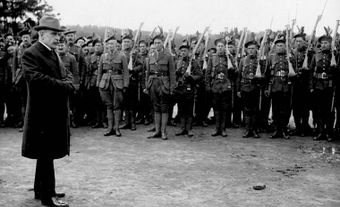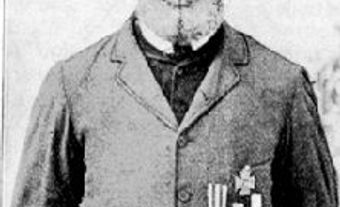Militia Acts
Militia Acts provided manpower for defence. Until the 1850s, such Acts in Upper and Lower Canada, Nova Scotia and New Brunswick usually imposed compulsory service on males between 16 and 50 or 60, with annual or more frequent enrolment musters. This institution, the Sedentary Militia, was unorganized and untrained. The Acts also authorized service battalions for transport duties, operations, etc. This Active Militia was composed of volunteers, supplemented if necessary by the ballot (selection by lot). In 1846 an Active Militia 3000 strong was provided for in the Province of Canada. In 1855 much of Canada's British garrison left for the Crimea, and patriotic excitement enabled approval of legislation for an Active Militia of 5000 to be equipped, trained and paid. In 1856 additional Active Militia companies without pay were authorized.
Fearing invasion during the American Civil War, John A. Macdonald introduced a bill (1862) to provide an Active Militia of 50 000, to be selected by ballot if necessary, and to be equipped and paid for 28 days' training. The bill's defeat brought about the fall of his government. In 1863 PM John Sandfield Macdonald provided that the Sedentary Militia would be retained and service battalions could be called out for 6 days' drill a year; 35 000 volunteers would be equipped but not paid. George-Étienne Cartier's Militia Act of 1868 retained the theory of conscription but recognized voluntary training as the backbone of the Dominion's militia system: 40 000 infantry, organized in companies in military districts, formed an Active Militia. The Militia Act of 1883 added permanent staffs for militia schools, the nucleus of a permanent force.
In 1904, after a series of confrontations between British general officers commanding the Canadian Militia and the minister of militia and defence, a Militia Act set up the Militia Council of civilians and military officials, including a chief of the General Staff. The bill doubled the Permanent Force to 4000 to provide a garrison to replace the British at Halifax. The 1922 National Defence Act brought the Militia, the Naval Service, and the Canadian Air Force together under the Department of National Defence.
See also Armed Forces: Militia AND Army.

 Share on Facebook
Share on Facebook Share on X
Share on X Share by Email
Share by Email Share on Google Classroom
Share on Google Classroom


